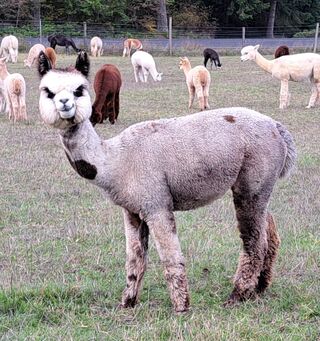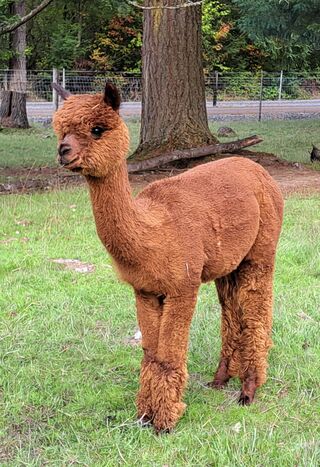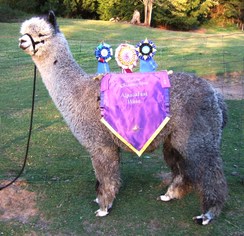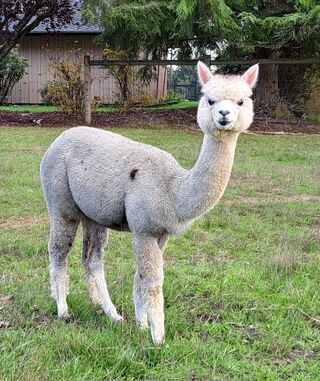Alpaca Facts
Compliments of Kissin’ Coussens Alpacas
~Alpacas are members of the camelid family along with llamas and the wild, fawn-colored guanacos and vicunas. Alpacas are believed to have descended from the vicuna and llamas from the guanaco. Alpacas have an amazing history.
~The ancestors of modern camelids evolved in North America beginning 40 million years ago. Some migrated to South America three million years ago. They became extinct in N.A. and only the guanaco and vicuna remained 12,000 years ago.
~For the last 6000 years, the curious, yet shy alpaca has been bred by humans. Selective breeding practices were used, most notably, by the Pucara and Incan cultures, to produce exceptional fiber. Ancient fabrics and recent scientific evidence provides proof that ancient cultures developed very successful, selective alpaca breeding programs. Alpacas and llamas also played a major role in religious ceremonies. In South America, alpacas are still used to provide clothing, food and fuel.
~In the 1500's, vast herds of camelids were destroyed by the Spanish during their conquest of the Incan empire. The remaining natives and their animals suffered further losses from European diseases and fled to the high altitudes of the Andes mountains where nighttime temperatures dip below freezing 300 nights a year. Sadly, experts estimate that 90% of the alpacas and 80% of the indigenous peoples were lost during this time. This event created a "genetic bottleneck" and increased the inbred population of alpacas as well as crossbreeding with other camelids. In more recent times, alpacas and people were killed in South America due to serious political unrest.
~There are two types of alpacas, differentiated by their fiber types. Huacaya alpacas have crimpy, fluffy-looking fiber and the very rare Suri has fiber almost no crimp and hangs in stringy locks.
~Today, world-wide, only about 5,000 tons of alpaca fiber is produced annually. Compare this to the many millions of tons of sheep wool production.
~Quality alpaca fiber has a very soft and silky "handle" (feel) and is also known for it's strength, exceptional warmth, luster and drape. Many ancient alpaca textiles still exist that are hundreds of years old, in near perfect condition and exhibit superb fiber qualities rarely found in today's alpacas. Alpaca breeders today are working to "unlock" and improve on these ancient genetics and to create the best alpaca fiber ever known.
~Alpaca fiber's softness can be attributed to it's smooth scale structure, uniform fineness and long staple length. Top-quality alpaca garments do not feel scratchy to the skin. Slightly coarser fiber contains hollow spaces, called medullation, which improves the fiber's insulating ability.
~There are approximately 2.5 to 3 million alpacas in the world. There are approximately 80,000 in the USA.
~South American countries did not allow alpacas to be exported in quantity until recent times. Alpacas were first imported into the United States in significant numbers in 1983. The first imports were from Chile and later imports came from Bolivia , Chile and Peru (Peruvian, PP…, PPP…, 4Peruvian, 5P… and 6P…are designators for the ‘93 to ‘98 Peruvian imports). Alpacas cross borders in South America, but generally speaking, alpacas from each country of origin have unique desirable traits that can be incorporated into a successful breeding program.
~Approximately 80% of U.S. alpaca owners have less than 20 alpacas.
~1998 was the last year that imported alpacas could be registered with the Alpaca Registry, Inc. (ARI) as the (mostly U.S.) members voted to "close" the registry (for imported alpacas) which shut down importations into the U.S.
~Alpacas are easy on the land and use communal dung piles, making clean up easy. In fact, alpaca owners who have raised other types of livestock say that alpacas are the easiest to keep.
~Alpacas have lower incisor teeth and an upper "dental pad" for grazing and molars for chewing and ruminating. They have two soft toe pads with a v-shaped nail on each foot which requires trimming about every 2 months.
~Mature alpacas weigh on average between 120 and 180 pounds., with some tipping the scales in the low 200’s.
~Alpacas have extremely strong herd instincts and unique behaviors. Because of this, at least two alpacas must be kept together.
~Alpacas are hearty animals and are adaptable to many types of environments. At a minimum, they require a lean-to for protection from harsh weather. Extreme heat, especially with humidity or extreme cold requires special herd management.
~About 6 to 10 alpacas can be kept per acre of good-quality, well-drained pasture.
~Depending on the seasonal quality of pasture and the need of individual alpacas, they are also fed orchard grass hay, a pelleted supplement formulated for alpacas and occasionally alfalfa for producing females. Additional alpaca vitamin and mineral supplements may also be given to help ensure optimal health and production.
~Basic care for 10 to 15 alpacas takes about one hour per day. They are very easy for a barn-sitter to care for when their owners are away.
~Alpacas require regular vaccines and treatment for internal and external parasites as needed which is similar to the requirements of other domesticated livestock.
~Alpacas can be kept adjacent to other species of livestock. It is recommended that alpacas have their own pasture as they have different behaviors from other types of domestic livestock.
~One's first impression of alpacas is usually the animal's alert, inquisitive, yet cautious nature. They have been erroneously described by a few as "stupid". In time, one begins to realize their often stoic nature and their extreme intelligence. Their main goal in life is survival and strong protection instincts are evident in their behavior. Careful training and handing results in an alpaca that will tolerate husbandry procedures and accept its owner. What a reward it is to be trusted by your alpacas!
~Each alpaca has it's own unique personality and temperament. Many breeders consider temperament when making breeding decisions. Proper training is crucial for an easily managed alpaca.
~Did you know that Ringling Brothers Circus used alpacas?!
~Various training techniques are used to teach alpacas how to halter, lead, pack light loads, pull a light carriage, run obstacle courses and even receive an injection and other treatments unrestrained.
~Alpacas are easy to train and generally safe for children to be around. (Note: I make exceptions for the occasional enthusiastic pronk (jump), some studs, and the very rare, improperly bottle-fed male that has become "bezerk" and view humans as their opponents. Better to be safe than sorry I always say.)
~The gestation period is 11 to 12 months and their life expectancy is 15-20 years on average.
~Females are usually mature enough to be bred at around 18 - 24 months of age. Males can settle their first female by 22 to 36 months of age. The female ovulates only in response to being bred and ideally can produce one cria each year until she is about 15 years old. Twins are extremely rare.
~The main goal of breeding is to produce a sound animal that produces a high annual yield of "prime" fiber (the best fiber from the alpaca's shoulder, back, rump, sides and sometimes neck and upper legs). There are uses for all qualities of fiber from all over the alpaca's body.
~22 primary fleece colors range from white to black [sorry, no purple yet, but we're working on it!] and includes rose-gray, a color unique to the alpaca. The vast majority of alpacas in the world are white due to the demand from the mills in South America over the last several decades. Many U.S. breeders are attempting to produce more colored alpacas with the fiber quality of the best white alpacas. Alpaca fiber accepts dyes beautifully and is also blended with other fibers.
~Alpacas are shorn every year. Younger alpaca’s fleeces are finer and grow longer than the fleece of older alpacas.
~Cleaning the fleece before shearing and "skirting" (removing debris and any non-uniform fiber from the prime fleece) helps to ensure a quality end product.
~An alpaca's fleece requires minimal maintenance during the year. A dense fleece stays cleaner than a loose, "open" fleece. In the U.S., the fiber is picked free of debris before shearing and further cleaned, skirted and sorted after shearing. Many artisans use the fiber straight from the animal and wash it after it has been spun or made into a finished product.
~Alpaca fleece is grease-free. It contains a light residue called "suint" from skin glands which helps to protect the fleece and the alpaca and aids the spinning process. Many people who are sensitive to sheep's wool are able to wear alpaca.
~Alpacas have a double coat made up of primary follicles (kemp or guard hair) and more numerous secondary follicles which are typically finer than the fiber from the primary follicles. The ultimate breeding goal for the improvement of alpaca fleece is to create a completely uniform and fine fleece, where the primary fibers and secondary fibers have the same characteristics over as much of the alpaca‘s body as possible and for as many years as possible.
~Annual fleece yields, with a staple length of about 2 to 6 or more inches, range from under 2 to over 12 pounds, with 4 to 9 pounds being about average. A 90% usable yield can be expected from each fleece (sheep net about 40% to 60% of usable wool from each fleece).
~Breeders and commercial processors grade alpaca fiber by it's diameter, measured in microns on a “histogram“. Alpaca fiber typically coarsens as the animal matures and most measures between 17 (baby) and 27 (adult) microns in diameter.
~Pet quality alpacas make wonderful fiber producers, pasture mowers, companion and 4-H animals.
~There are many mills in the U.S. that process specialty fibers, including small lots of alpaca fiber.
~Alpaca prices have been strong since the inception of the U.S. industry through the present. Recently, alpacas have sold for anywhere between $500 and a record-setting $600,000 for full interest in a champion producing stud as well as $750,000 for half interest in another top producing stud. The current record prices for females are $205,00 and $305,000. Many books, hundreds of articles, experts, breeders, shows and organizations are available for enthusiasts and new owners to learn more about the amazing alpaca.
~Breeding stock and breedings are sold with contractual guarantees which can vary seller to seller.
~ Alpacas are an insurable livestock.
~ Fiber artisans, world-class fashion designers, researchers and veterinarians, and breeders have dedicated themselves to the health and well-being of the alpaca and the unique fiber they produce.
~The alpaca industry will to continue to develop and expand as an exciting, growing and profitable industry.
May 23, 2011



